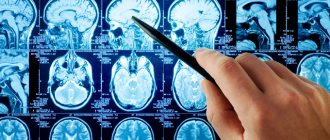What does delusion of grandeur have to do with it?
Paraphrenic syndrome is characterized by an overestimation of one's own importance. A person begins to compare himself with someone great, becomes obsessed with the idea of his uniqueness and his own superiority.
Many begin to think that they have superpowers, and sometimes even consider themselves the chosen ones, those with whom the higher mind communicates. All this megalomania leads to hallucinations, because it is thanks to them that the patient manages to believe that he is truly special.
Causes
Paraphrenia and its causes are not well understood. However, there are a number of factors that contribute to its development:
- Genetic predisposition (on the maternal side, less often on the paternal side);
- Unfavorable social and environmental conditions;
- Mental illnesses (schizophrenia, vascular and atrophic psychoses, etc.);
- Characteristics (excessive tearfulness, suspiciousness, aggressiveness);
- Bad habits (smoking, alcohol, drugs);
- Stressful situations (death of a loved one, frequent conflicts);
- Cerebrovascular accident;
- Skull and brain injuries;
- Oncological diseases.
Rarely does any isolated factor occur; most often, it is their combination that causes the occurrence of pathology.
For the development of paraphrenic syndrome there must be a psychological and genetic basis. Even severe stress cannot cause this condition unless there is a hereditary predisposition. However, if paraphrenia is observed in at least one of the parents, the risk of its occurrence in the child is very high. Moreover, it is most often observed in people with schizophrenia.
The line between lies and illness
Paraphrenic syndrome can be confused with a love of fantasy. For example, the schizoid type is characterized by withdrawal into their inner world and their fantasies. Inventing his own world, a person meanwhile begins to believe that everything is really as he imagined. In paraphrenia, false stories are also observed, but if in schizoid disorder they always go in one line, then in a delusional patient they are always different, changing and not consistent with each other.
Fictional characters are not just non-existent people, they are those who simply cannot exist in the world: people with tentacles and three heads, deceased famous personalities. Even if you catch such a delusional patient in a lie, you can be sure that he will continue to assure that all this is actually true. Paraphrenic syndrome manifests itself in everything except the verisimilitude of statements, they are always untruthful, and any sane person can understand this.
General symptoms
Paraphrenic syndrome is characterized by several types of symptoms:
• Hallucinatory type. The patient experiences verbal hallucinations. In other words, he hears voices from outside or inside himself. They are the ones who instill fanatical ideas and distort reality. They are also often called pseudohallucinations.
• Systematized type. Delusional thoughts are already firmly established in the patient’s consciousness and become persistent. If with the hallucinatory type there is still a chance that a person can independently realize the delirium of his ideas, then with this type this becomes impossible. Gradually, thoughts begin to be structured, but in the wrong direction.
• Confabulatory type. Develops in a single combination with the first two types. The replacement of memories with false ones begins. A person begins to talk about the events of the past in a different color, with other details or facts. Along with this, delusions of grandeur begin to develop. Stories from the past are mainly related to something that made the patient special, different from everyone else.
• Mental automatism. The patient begins to communicate with fictional characters. Fictitious in the sense that these people are not actually talking to him. These could be those who are living today, or those who have long since died. There may be aliens or other fantastic creatures. At the same time, the person begins to assure everyone that he has abilities that he did not have before. For example, the ability to manipulate people, read their thoughts, move objects, dissolve in the world around them, and be invisible.
Diagnostic measures
The main method of diagnosis is psychiatric examination. The specialist determines the presence of delusional ideas, hallucinatory disorders and mental automatisms. Important information about the patient’s condition can be obtained from his relatives or colleagues, since the person himself is not critical of delirium and other disorders.
Of additional importance is the implementation of instrumental methods of examining the brain to exclude organic pathology. For this purpose, magnetic resonance imaging (MRI) and electroencephalography (EEG) are performed. MRI allows you to identify defects in changes in the structures of the central nervous system - tumor foci, cysts, consequences of neuroinfections, etc. EEG is used to study the functional activity of individual zones of the cerebral cortex. When changes are identified, the causes of their occurrence are identified and appropriate therapy is prescribed.
Differential diagnosis is carried out with paranoid and paranoid syndrome. Similar conditions occur against the background of schizophrenia and organic brain damage. They develop with a certain type of personality and the presence of provoking factors, while there is one main idea of delirium. Paraphrenic syndrome includes all of the above, except for monothematic delirium, and also has a greater severity of mental disorders.
Symptoms borrowed from other disorders
In addition to its symptoms, paraphrenic syndrome has the same manifestations with other syndromes, namely:
• Capgras syndrome. There is a replacement of strangers with familiar people and vice versa. Real friends, close people and even family members are perceived as strangers and previously unknown. But those whom the patient has never known become dear and close. He begins to mistake those around him for strangers in disguise, trying to gain his affection and trust.
• Fregoli's syndrome. One and the same person in the eyes of the patient begins to take on the appearance of different people. For example, seeing a friend, a patient may first recognize him, at the next meeting consider him some kind of famous athlete, and subsequently even a creature from a fairy tale. At the same time, he will sincerely believe that this is really so.
Classification
Depending on the predominance of a particular symptom, in addition to delusions of grandeur, the following forms of paraphrenic syndrome are distinguished:
- Hallucinatory - auditory or visual hallucinations predominate, sometimes a combination of both;
- Depressed - the patient is depressed, considers himself to blame for everything bad that happens. Personifying himself as a terrible person, he is prone to complete suicide;
- Confabulatory - the patient covers up memory gaps with invented situations and actions;
- Manic - a sense of self-importance correlates with fantastic ideas and statements;
- Systematized - fear of people because they can cause pain, combined with fictitious colorful phrases and hallucinations.
Types of disease:
- Acute paraphrenia is a single attack of paraphrenic syndrome; later, in the absence of treatment, the pathological process becomes chronic. Characterized by depressive feelings or manic delusions in combination with hallucinatory phenomena;
- Chronic paraphrenia is a series of delusional ideas that develops against the background of constantly recurring attacks of psychosis. The symptoms are complicated by speech disorders: lack of logic in sentences, fragmented thoughts.
RELATED MATERIALS: How to treat cephalalgia (headache) correctly, without harming your health?
Features of speech
Paranoid, paranoid, paraphrenic syndromes are all characterized by clearly impaired speech. It is replete with facts of a universal scale, various figures and calculations, comparisons. The patient, trying in every possible way to prove his importance to the whole world, cites scientific facts that prove this. He begins to talk about what only he knows, about unknown events, wars in outer space. Moreover, any disagreement with his point of view will be constantly refuted.
Varieties
Like any other syndrome, paraphrenia has its own varieties:
• Melancholic paraphrenia. This is a type that is closely associated with depression. It occurs already at a late age. It is dangerous because delusional ideas, instead of elevating a person to the rank of special, which would be better than self-flagellation, lead precisely to self-flagellation. A person is sure that he deserves humiliation, and whenever possible he tries to humiliate himself.
• Involutional paraphrenia. Also typical for elderly patients. A feeling of persecution begins, that everyone around is a danger. A person, believing that he carries something unique within himself, tries in every possible way to protect it from external imaginary enemies. This type of paraphrenic syndrome leads to memory deceptions (a person begins to get confused in it, deliberately replacing some facts in memories), sudden mood swings, and changes in speech at the time of exacerbation of delirium.
• Presenile paraphrenia. Occurs in women aged 45 to 55 years. It is characterized by the idea of greatness through connection with someone even greater. For example, delusional fantasies of sexual communication with an alien intelligence may arise. At the same time, auditory hallucinations in every possible way fuel the belief in the veracity of these circumstances.
• Acute paraphrenia. This is more of an attack of schizophrenia than a paraphrenic syndrome. The medical history confirms this in all cases. Delirium in this case is sensual and figurative. Patients claim that they really feel everything they talk about. For example, how a fictional character touches them.
• Erotic paraphrenia. Affects women more often than men. Almost all patients have a bad family life, which becomes the impetus for the development of this kind of delirium. Hallucinations are reproached for immorality, and they are threatened with sexual violence for this. The charges may be related to cheating on your spouse. It occurs in old age and is paroxysmal in nature.
• Late paraphrenia. The latest of all types, since it is diagnosed at the age of 70-80 years. Patients feel that they are being harmed and offended. Refers to senile schizophrenia and is difficult to cure.
PARAPHRENIC SYNDROME
PARAPHRENIC SYNDROME
(Greek, para about + phren mind; syndrome; synonym:
paraphrenia, fantasyophrenia, paraphrenic delusion, fantastic-paranoid syndrome
) - a psychopathological symptom complex in which delusions of fantastic content dominate, often combining grandiose delusions of grandeur with ideas of persecution and (or ) effects, accompanied by changes in affect and, often, auditory hallucinations and pseudohallucinations.
The content of paraphrenic delirium is usually dominated by ideas of greatness with varying degrees of systematization and fantasticality. Along with delusions of greatness, power, and genius, ideas of messianism, reformism, wealth, special origin, as well as delusions of erotic content may arise. Delusions of grandeur are usually bizarrely combined with various ideas of persecution, a constant threat of destruction with the participation of all-powerful organizations, gangs, etc. Patients believe that they are in the center of unusual and sometimes grandiose events. In some cases, Manichaean (antagonistic) delusions may occur (see Delirium). Delirium can take on a retrospective character.
Of the sensory disorders, the most common are verbal hallucinations, including in the form of hallucinosis (see Hallucinations), various manifestations of Kandinsky-Clerambault syndrome (see Kandinsky-Clerambault syndrome) and false recognitions (see Capgras symptom). These disorders, in accordance with the characteristics of delirium, also receive fantastic content: patients talk about the effects of intercontinental and spacecraft, about meetings with famous people, etc.
Affective disorders manifest themselves most often in the form of elevated mood, the degree of which ranges from hypomania to severe manic states (see Manic syndromes).
Depending on the characteristics of the manifestations, several forms of P. s. With systematized paraphrenia, consistently developed delusional ideas dominate with a predominance of persecution over greatness. With fantastic paraphrenia, multiple, devoid of consistent systematization, grandiose ideas of greatness dominate. The predominance in the wedge, the picture of delusional confabulations (see Confabulosis) is characteristic of confabulatory paraphrenia. Expansive paraphrenia is characterized by manic affect. In hallucinatory paraphrenia, sensory disorders of fantastic content predominate.
Patients with systematized paraphrenia are reserved and arrogant, inaccessible, and prone to irony. Patients with other forms of P. s., despite the emphasized sense of self-esteem and patronizing attitude towards others, are usually talkative and flexible. In the statements of patients with P. s. neologisms are often found (see Speech, speech disorders in mental disorders).
P.S. occurs in chronically ongoing diseases (chron, forkhma P. s.) following other, simpler syndromes, including delusional ones - paranoid syndrome (see), paranoid syndrome (see) with a predominance of verbal hallucinations - and is a sign of disease progression. So, most often and in the most diverse forms of P. s. occurs in schizophrenia (see). In some cases, it occurs with traumatic brain injury, alcoholism, syphilitic psychoses, and in the initial period of senile dementia.
Along with hron, the form of P. s. there is a so-called acute paraphrenia (acute P. s.), which occurs most often with paroxysmal schizophrenia in the form of rapidly developing exacerbation (outbreak). The content of delusions in acute paraphrenia is usually figurative with continuously changing fantastic content and the presence of enthusiastic affect or despair. The dynamism inherent in acute paraphrenia greatly brings its manifestations closer to those of oriented oneiroid (see Oneiroid syndrome).
Treatment
carried out with psychotropic drugs, the choice of which is determined by the wedge, the picture of the underlying disease.
Prevention
consists of timely treatment of the underlying disease. The use of psychotropic drugs in the treatment of schizophrenia led to a decrease in the number of patients with extensive P. s.; more often it appears in a reduced form.
Bibliography:
3latan B. D. Clinical features of hallucinatory paraphrenia, in the book: Psycho, disorders in organic lesions of the center, nervous system. systems, ed. A. G. Naku and B. D. Zlatan, p. 139, Chisinau, 1970; Kogan Ya. M. On the structure of paraphrenic diseases, Odessa, 1941: M o f e s S. M. On the issue of alcoholic paraphrenia, Zhurn, neuropath, and psychiat., t. 70, century. 5, p. 740, 1970; P o-p about in Yu. P. Confabulatory-paraphrenic symptoms in old age, On the question of the nosological place of involutional paraphrenia, in the book: Involutional psychoses, Clinical forms, ed. G.B. Morozova et al., p. 110, M., 1979; Portnoy A.A., Buntov G.O. A. and JI s-to in B. D. Syndromology of paraphrenic delirium and similar conditions, Zhurn, neuropath, and psychiat., t. 68, century. 6, p. 890, 1968; Sokolova B.V. On the clinic and psychopathology of acute paraphrenic states, in the same place, in. 5, p. 754; F a v o r i-n a V. N. About periodic schizophrenia with paraphrenic syndrome, in the same place, t. 59, century. 1, p. 83, 1959; Lemperiere, Les parapliit'jiies, Encephale, t. 46, p. 1, 1957.
N. G. Shumsky.
Reasons for the development of the syndrome
The syndrome can occur independently, or it can only be a sign of some disease. It can be caused by: schizophrenia, manic syndrome, psychosis (especially senile). The reason may also be:
• Genetic predisposition to mental illness. You should not be surprised if suddenly a child of mental patients begins to delusion.
• Problems with brain activity. Any disturbances in his work from birth or due to some injury or disease such as meningitis.
• Abuse of narcotic, psychotropic drugs and alcohol.
Causes
Paraphrenic syndrome is not an independent disease. In psychiatry it is classified as a manifestation of paranoid schizophrenia. The occurrence of delusions and hallucinations can also occur in other diseases - delusional disorder and atherosclerotic psychoses.
The development of paranoid schizophrenia is based on genetic factors and environmental influences. Imbalance of neurotransmitters in the brain can be hereditary. Other reasons include:
- use of drugs and alcoholic beverages;
- severe acute and chronic stressful situations;
- unfavorable family environment, which is accompanied by violence;
- traumatic events.
These factors increase the severity of the imbalance of mediators in the structures of the central nervous system and lead to the development and progression of schizophrenia.
Treatment
Treatment for the disorder is possible. It is carried out in several stages. First, patients are prescribed antipsychotic drugs; they help stabilize the patient’s general condition and, in addition, reduce delirium. If there is also a depressive disorder, the doctor prescribes antidepressants. Patients take medications in large dosages while in hospital treatment; at home they only continue to take a small dose of medication. The final stage of treatment is a course of psychotherapy with a specialist.
Treatment of paraphrenia
Treatment of paraphrenic syndrome is carried out both in an inpatient setting and on an outpatient basis, when the patient is required to appear for medication at a clearly established time.
The most effective group of drugs used for this pathology are broad-spectrum neuroleptics, which relieve or reduce psychomotor agitation, neutralize the level of anxiety and reduce the delusional effect.
For melancholic paraphrenia with a predominance of depressive dramatizations, antidepressants are additionally used. The nature of the disease also leaves its mark on drug therapy: in the chronic syndrome, the use of antipsychotics will be regular with a constant increase in doses, in contrast to the acute form, when antipsychotics are used at the time of clinical manifestation, in a shock dose.
As a rule, patients with more severe disorders are placed in the clinic, when their activities can harm others or lead to damage to property. After the level of manifestation of disorders has decreased, the patient can undergo treatment on an outpatient basis, using lighter drugs in lower dosages.
It should be remembered that after completion of treatment, complete disappearance of signs of the disease is extremely rare; relapse occurs in 90% of cases.










